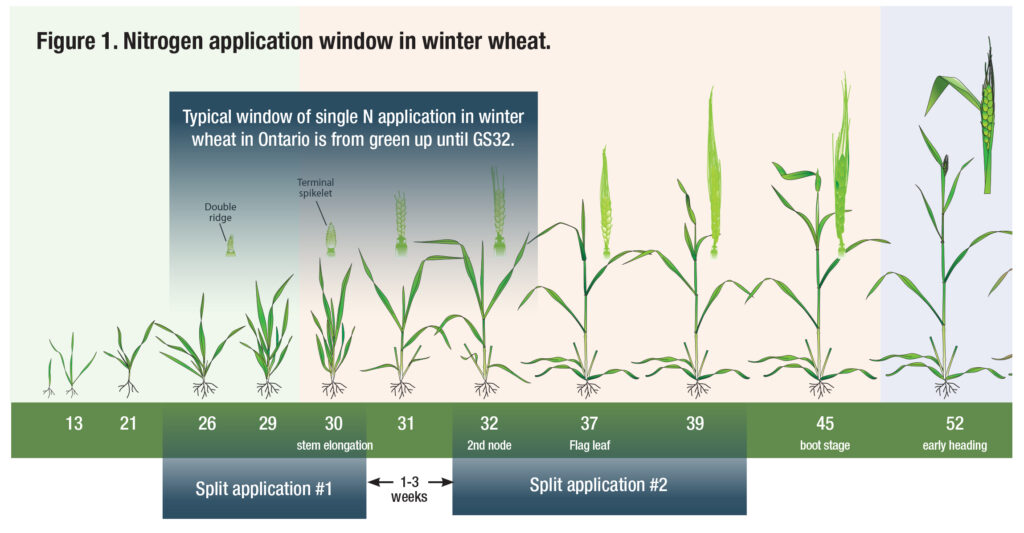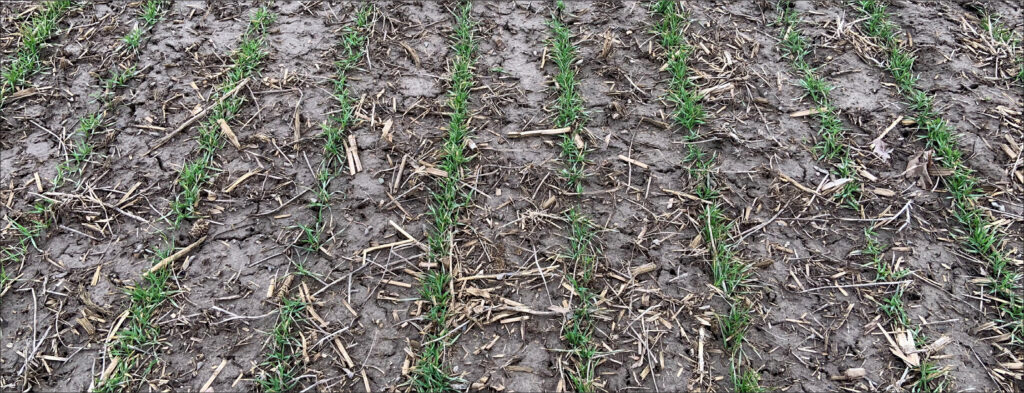Depending on the year and field conditions, you might get a yield bump from a split application of nitrogen (N) on your winter wheat crop. We’ve looked at a few different factors that might impact your N application decision.
The simple answer
Well, sometimes the simple answer is…it depends. When you are looking at the pros and cons of split applications in winter wheat, here are a few factors to consider.
| Single N application | Split N application |
| • One pass means convenient, low application costs • Can produce high yields if lodging risk and N losses are minimal | • Allows for early N and sulphur (S) applications to stimulate or maintain tillers in late-planted wheat, and minimize N loss • Potential to increase efficiency of N use, especially with high fertilizer prices • Tailor N management strategy based on the season and perceived yield potential • Reduce lodging risk while using higher rates of N to maximize yield potential • Potential for increasing protein in hard red varieties |
A little more information
When planning your N management strategy, there are several factors to consider for maximum returns including crop development stage, variety and field-specific characteristics. In some years, split N applications may provide little or no benefit to yield compared to a single application (Table 1). This chart compares wheat yields over a three-year period using a single N application (green) and split N applications (blue and red). Each application – whether single or split – was made at a specific crop development stage, that was not consistent year to year because of varying weather conditions.

Yields with no letter in common are significantly different. Yields were not significantly different between the single N (green bar) or split N application (blue bar – 50% at green up, 50% at GS30). Yields from a split N application where the second pass was made later (GS32 – red bar) were significantly lower in 2011 and 2013, but significantly higher in 2012. There is a 5% chance that yields from all three N application strategies are not significantly different.
The full story
Figure 1 shows key growth stages (GS) of winter wheat and corresponding recommendations for N application.

Fields with minimal growth and tillering early in the spring tend to benefit from an application of N and S at green up (Figure 2). This early application helps to maintain and encourage additional tillering. If the first application is held off until later in the spring when plants reach GS30, some tillers may be lost if N is deficient. With an early application at green up, a second application can be made between GS32-39. A single application strategy with all N applied upfront may not be advisable if applied at green up because of N loss potential.

Figure 2. Green up. Late planted winter wheat benefits from an early N application to encourage tillering as the crop begins to green up. A good split N strategy in this scenario is 60% of N + 10 lb of S in the first application, and 40% of N in the second application.
By contrast, the risk of lodging is greater in early planted fields with high seeding rates using a variety susceptible to lodging or too many tillers (Figure 3). In these fields, delaying an N application until GS30, and applying only a portion of total N, may reduce the risk for lodging by shortening the lower stem internodes and discouraging more tillers. The second application can be made between GS32-39.

Figure 3. GS30. Early planted winter wheat field with 8+ tillers and history of manure would benefit from a delay in N application until closer to GS30, versus green up, to reduce lodging risk. A good split N strategy in this scenario is 40% of N + 10 lb of S in the first application, and 60% of N in the second application.
Field specific characteristics
Soil type is an important factor to consider in your N management strategy. N losses through leaching and/or denitrification are more likely to occur with early-applied N on wheat before the onset of rapid N uptake (GS30). Potential N losses tend to be highest on sand and clay soils (less so for loam) but remember that losses are insignificant if rainfall after an N application is not excessive. Early N applications also enable an early application of S – an important factor on sandy soils or soils with low organic matter levels and no history of manure. Sulphur deficiencies tend to occur early in the growing season before soils warm up and mineralization begins.
A look at costs
Table 2. Application costs associated with single and split nitrogen application.
| Single application (~GS30) | Split application (1st <GS30, 2nd ~GS32-39) | |
| Application (includes mixing and delivery) | $12.10 | $12.10 x 2 |
| Total application cost | $12.10/ac | $24.20/ac |
| Additional yield (to cover application cost) | – | 1.3 bu/ac |
A few other considerations
An early, single application of N often does not allow for a change in the total amount applied as the season progresses. And if an excellent yield potential is evident during GS32-39, and you are reluctant to add more N in an unplanned pass, the full yield potential of the crop will not be achieved.
There are several risks when too much N is applied in a one-application strategy:
- Potential for greater N loss, wasting money (especially when fertilizer prices are high) and increasing environmental costs
- Increased risk of lodging and disease with a thick crop canopy
- Lodging reduces harvest efficiency and increases grain losses
A split N application strategy reduces the impact of all these risks.
